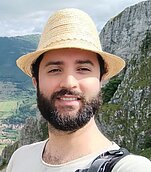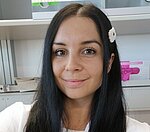Student Speakers
Anna Seubert
Kretzschmar Lab, Biomedicine
The site-specific cellular compositions of the adult murine oral mucosa are illuminated through single-cell transcriptomics
We are constantly exposed to pathogens, toxins, and carcinogens in the environment in which we live. One of the body sites directly exposed to these external challenges is the mouth, which is essential to our ability to breathe, eat, taste, and speak. The inside of the mouth, the oral cavity, is covered by the oral mucosa, which can be divided into oral sites. These sites, such as the tongue, cheeks, and palate, are highly heterogeneous and contain unique microenvironments (niches) for oral epithelial stem cells (OESCs). The oral sites and their stem cell niches remain poorly understood. Therefore, our goal was to investigate how the heterogeneity of oral sites is maintained by OESCs and their niches. Using the mouse as a model, we first found that proliferation rates and organoid-forming capacities are oral site-specific. To unravel the cellular heterogeneity of oral sites and the mechanisms driving oral site-specific stemness and differentiation, we performed single-cell and spatial transcriptomics of all major mouse oral sites. We provide an oral cell atlas containing the transcriptome of more than 23,000 single cells from all major cell lineages, including epithelial, stromal, and immune cells. By sub-clustering these different lineages, we identified several oral site-specific cell clusters. Through ligand-receptor analysis, we revealed a site-specific communication network between epithelial and stromal cells that influences stemness and epithelial differentiation. For example, buccal and palatal stromal fibroblast populations are transcriptionally distinct from tongue fibroblasts. To validate our findings, we performed histology, whole-mount imaging, spatial transcriptomics, and functional organoid-based assays. Building on this comprehensive dataset, our long-term goal is to elucidate the key molecular mechanisms that influence OESCs and their oral site-specificity during tissue homeostasis, regeneration, and diseases such as cancer.
Christopher Nauroth-Kreß
Pham Lab, Neuroscience
Automated segmentation of the Dorsal Root Ganglia (DRG) and DRG imaging biomarkers in Fabry disease
The dorsal root ganglia (DRG) are small paired organs right next to the spine, beside their small size they contain all primary somatosensory cell somas. Several studies focus on their role in emergence of chronic pain and how they can be a target for optimized pain therapy. Fabry disease (FD) is a rare lysosomal storage disorder caused by mutations of the X-chromosomal gene GLA, encoding the enzyme alpha-galactosidase A. Due to the impaired enzyme function, patients accumulate globotriaosylceramide in several organs and also in neurons. One of the earliest symptoms of FD is pain. We found two DRG MR imaging biomarkers to be associated with FD genotype (volume) and pain phenotype (T2w signal intensity) opening up new possibilities to investigate the involvement of the DRG in painful FD. To extract these biomarkers, voxelwise segmentation of MR images is needed. DRG segmentation by experts is very time consuming and prone to bias, making this approach unsuitable for clinical application or larger cohorts across different sites. Therefore, we trained machine learning models using the nnU-Net framework to automate and objectivize the segmentation process. Here we further investigate the role of our imaging biomarkers and the quality of our segmentation model on a new dataset of FD patients. Therefore, we combine high resolution T2w SPACE sequences for volumetry and T2 maps for T2 signal extraction with state-of-the-art artificial intelligence, to further improve the quality of the imaging biomarkers and investigate the connection between the DRG and pain in Fabry disease.
Daniel Rodríguez
Department of Animal Ecology and Tropical Biology
The expression of elongases and desaturases shed light on the CHC plasticity of honey bees (Apis mellifera)
Cuticular hydrocarbons (CHCs) protect insects from water loss and mediate inter- and intraspecific communication. These functions depend on the composition of the CHC layer, which is determined by the diversity and the regulation of genes responsible for the biosynthesis of hydrocarbons. The expression of enzymes in the biosynthetic pathway such as elongases, which elongate the hydrocarbon chain, and desaturases, which introduce double-bonds into the hydrocarbon chain, determines the abundance and richness of compounds in an insect’s CHC profile. In the honey bee (Apis mellifera), CHC profiles vary among castes, social roles, and subspecies. However, little is known about the genetic basis for such variation. Here, we examined the correlation of the expression of two elongase and two desaturase-genes to the CHC composition of nurse and forager workers of two highly divergent honey bee subspecies: Apis mellifera carnica (lineage C) and Apis mellifera iberiensis (lineage M). We found a correlation between the CHC composition and the expression of our candidate genes, that is consistent with the catalytic function of the respective enzymes. Moreover, we provide evidence for differences in substrate specificity between different elongases and desaturases.
Franziska Liss
Gaubatz Lab, Biomedicine
Novel interaction between B-MYB and TRRAP mediates histone acetylation of cell cycle gene promoters
The cell cycle is a tightly regulated process to ensure proper cell division. Cell cycle checkpoints ensure that only cells with fully replicated and intact genomes genome can undergo division. The inability to pass these checkpoints will lead halting of the cell cycle or cell death. In cancer cells, the cell cycle is oftentimes disrupted. Therefore, it is of interest to understand the mechanisms underlying cell cycle regulation further to better understand and treat cancer.
One of the major protein complexes involved in the proper transcriptional regulation of cell cycle-regulated genes is the MuvB complex. If cells progress through the cell cycle the MuvB core interacts with the transcription factor B-MYB and together they form the MYB-MvB (MMB) complex. MMB binds to the promoter of G2/M genes and activates their transcription.
As MMB does not contain any catalytic subunits, it remains elusive how it is able to induce gene expression. Recently, it has been suggested that MMB remodels nucleosome structure to allow for gene activation. Alternatively, MMB may recruit co-activators to cell cycle gene promoters. Consistent with this notion, we found through proximity-dependent biotin identification (BioID) experiments coupled with mass-spectrometry that several subunits of the Histon Acetylation (HAT) complexes TIP-60 and STAGA interact with B-MYB. Increased histone acetylation is a common mechanism for gene activation as it reduces histone and DNA interaction and therefore makes chromatin more accessible.
Through co-immunoprecipitation experiments, we were able to confirm the interaction between several HAT complex subunits and B-MYB. We primarily focus on the TRRAP subunit, which is known to be an adaptor for the interaction of HAT complexes with transcription factors. We have narrowed down the interaction site of TRRAP within B-MYB and through rescue experiments with a B-MYB mutant that lacks the interaction domain we have confirmed the biological significance of the interaction of TRRAP with MMB.
MMB-mediated histone acetylation could represent a future therapeutic target for the treatment of cancer.
Sebastian Häusner
IZKF Gruppe Tissue Regeneration in Musculoskeletal Diseases & Bernhard-Heine-Centrum für Bewegungsforschung
Improving bone regeneration in vitro - a 3D test system for autologous bone marrow transplants
The use of autologous bone grafts for defect reconstruction is currently the gold standard. In 2018 alone, 55 percent of approximately 100.000 bone union/non-union defects were treated using autologous bone grafting. Here, bone grafts demonstrate significant healing potential and favorable healing outcomes. Despite routine application of autologous bone grafts, which usually also contain large amounts of bone marrow (BM), its cellular composition as well as its soluble factors have only been poorly elucidated. Therefore the main aim of this work was to identify potent cell populations and soluble growth factors that are linked to the unique bone healing capabilities of BM. Bone marrow mononuclear cells (BM-MNCs) are a very heterogenous mixture of long- and short-lived, undifferentiated myeloid, lymphoid and hematopoietic cell populations. Therefore, in order to test bone healing strategies on BM-MNCs in a physiologically relevant context, the cells naïve phenotypes must be preserved during in vitro culture. BM-MNCs were isolated from femoral punch biopsies (ethics vote 25018) by density gradient centrifugation and characterized using flow cytometry with predefined extracellular marker panels. Minimally manipulated cells were seeded in human fibrin/ fibronectin and rat tail collagen hydrogels. In order to assess the cellular responses to growth factors/cytokines contained in BM autografts in 3D culture, the incubation media was supplemented with different donor derived supernatant. After 3 days of culture, hydrogels were lysed and cellularity assessed. The initially predefined flow cytometry marker panels were used to characterize the impact of 3D culture treatment on respective cellular main and subpopulation. A relevant test platform could be established using a fibrin/fibronectin hydrogel matrix, that reflects on the native heterogenous phenotypes of BM-MNCs. In the following stages, the healing strategies based on in vitro data will be put to the test in an ovine model.
Victoria Mamontova
The RNA methyltransferase 3 couples the long non-coding RNA NEAT1 with the recognition of DNA double-strand breaks
Long non-coding (lnc)RNA emerge as regulators of genome stability and are often deregulated in cancer. The paraspeckle-seeding nuclear enriched abundant transcript 1 (NEAT1) regulates gene expression by various means. NEAT1 promotes the retention of mRNA and sequestration of proteins with paraspeckles, but also accumulates on actively transcribed chromatin. Interestingly, the level of NEAT1 are overexpressed in many tumours and also induced by DNA damage, suggesting a genome-protective function. However, the precise role of NEAT1 in the DNA damage response (DDR) is unclear.
Here, we establish biochemical and cell biological tools that quantitatively assess the expression, localisation and modification levels of NEAT1 in response to DNA double-strand breaks (DSBs) induced by the topoisomerase-II inhibitor etoposide or the locus-specific homing endonuclease AsiSI. We find that the induction of DSBs increases the levels of NEAT1 and activates the RNA methyltransferase 3 (METTL3) to directly place N6-methyladenosine (m6A) marks on NEAT1. This fosters the accumulation of NEAT1 at promoter-associated DSBs and facilitates efficient DSB signaling. The depletion of NEAT1, in turn, delays the response to DSBs and triggers genome instability. Our findings suggest that NEAT1 promotes the condensation of broken DNA into DSB foci. The genome-protective function of NEAT1 is mediated by METTL3 and may involves DNA damage-induced changes in the structure and interaction with the chromodomain helicase DNA binding protein 4 (CHD4). Elucidating the molecular principles of the NEAT1-dependent DDR may pave the way for novel RNA therapeutic approaches and underscores the importance of studying NEAT1 for our understanding of genome maintenance and its vulnerability in cancer.
Nikolett Pahor
Diefenbacher Lab, Biomedicine
Protein stability in lung cancer - Investigating the role of USP10 in NSCLC
Lung cancer is the most common tumour type and the leading cause of death attributed to cancer. The majority of the patients (85%) are diagnosed with non-small-cell lung cancer (NSCLC), which two most frequent subtypes are adenocarcinoma (LUAD) and squamous cell carcinoma (LUSC) (1). The therapy of these tumour entities is challenging as the currently available drugs have short-term effects, thereby the five-year survival rate of patients still remains low. Utilizing the ubiquitin proteasome system (UPS) could be a potential window of opportunity to target tumour intrinsic vulnerabilities, since several studies have already revealed that cancer cells are highly reliant on a functional UPS for tumour initiation, maintenance and metabolism. Deubiquitinating enzymes (DUBs), which catalyze the counter-reaction of ubiquitination, one of the most common post-translational modifications of proteins, have received increasing attention as medication targets in recent years. Ubiquitin-specific protease 10 (USP10) is a DUB that is considered a double-edged sword in human cancers, as it reportedly acts as a tumour suppressor or oncogene depending on the tumour type and it’s genetic background. Regarding to lung cancer, its potential involvement and expression pattern hasn’t been fully characterized, the scientific literature is contradictory about it (3,4). Our aim is to determine the role of USP10 in lung tumour development in vitro and validate our results via ex vivo organoid and in vivo transgenic mouse models. Based on the results what we have achieved so far, we suggest an oncogenic role for USP10 in NSCLC.
Shazeb Ahmad
Smyth Lab, HIRI
Visualization of influenza genome assembly by direct RNA padlock probing and in-situ sequencing
Influenza viruses are important human pathogens that are responsible for annual epidemics and occasional pandemics. A striking feature of influenza is its segmented genome composed of 8 negative-stranded RNA segments (vRNAs). Within budding virions, vRNAs are organized into a characteristic 7+1 arrangement with seven vRNAs of different lengths surrounding a central one. Genome segmentation greatly complicates virus assembly. Nonetheless, it has evolved in many viruses because it enables segment exchange by reassortment. Importantly, past and recent influenza pandemics have arisen through reassortment between human, swine, and avian influenza viruses. Reassortment is known to be non-random and thus constitutes a barrier to cross-species virus transmission, but the mechanisms underlying non-random segment exchange are not understood. This lack of understanding can be attributed to the difficulty of studying all eight segments at the same time in cells.
Padlock probe (PLP) based spatial transcriptomics offers a way to localize individual influenza segments within infected cells. PLPs are oligonucleotides with two hybridizing arms and a loop region. After hybridization to the target, it is ligated into a circle and amplified by rolling circle amplification for subsequent detection. PLPs offer great discriminatory power but usually lack sensitivity because RNA molecules are usually detected via cDNA produced during an inefficient reverse transcription step. Here, we show that direct RNA targeting using an RNA-specific ligase greatly improves detection efficiency, and we further increase sensitivity towards single molecule detection using multiple PLPs. Finally, we show that in-situ sequencing of barcodes within the loop region enables highly multiplexed RNA detection and the visualization of all 8 influenza vRNAs and mRNAs simultaneously in infected cells. We also show the spatial information of the vRNA over time and their possible interaction.
PLP coupled with in-situ sequencing offers a way to understand the different aspects of influenza infection such as replication and transcription dynamics, assembly complex formation, and possible interactions of the segments during co-infection.

Shriya Jayaram
Antigen-specific therapeutics for NMOSD inspired by pregnancy
Neuromyelitis optica spectrum disorders (NMOSD) is a neuroinflammatory disease that results from the immune responses targeting the autoantigen aquaporin 4 (AQP4). Our study explores the potential of immunosuppressive MHC molecules expressed during pregnancy to induce selective tolerance to presented peptides. Specifically, we investigate whether HLA-G-derived molecules presenting AQP4 peptides can promote regulatory T cell responses in PBMCs from healthy donors and patients. We also assess if analogous mouse-adapted constructs provide protection in murine neuroinflammatory disease models. We designed single-chain molecules incorporating i) an autoantigen peptide, ii) human or murine MHC class I α1-α2 antigen-presenting domains, iii) an immunosuppressive HLA-G α3 domain, and iv) β2-microglobulin. These biomolecules, termed AutoImmunity Modifying Biologicals (AIM Bios), effectively polarize human CD8+ T cells towards a CD8+CD122+ IL-10-secreting Treg phenotype when carefully selected peptides are presented. Mouse-adapted AIM Bios elicit similar antigen-specific Treg responses and halted disease progression in spontaneous optic neuritis mouse (2D2) model. Furthermore, histological analysis suggests that AIM Bio-induced Treg protect the tissues expressing cognate antigens, including retina, spinal cord and optic nerve from apoptosis and effector T cell infiltration. This new class of molecules holds promise for targeted immune tolerization with minimal side effects in NMOSD.













